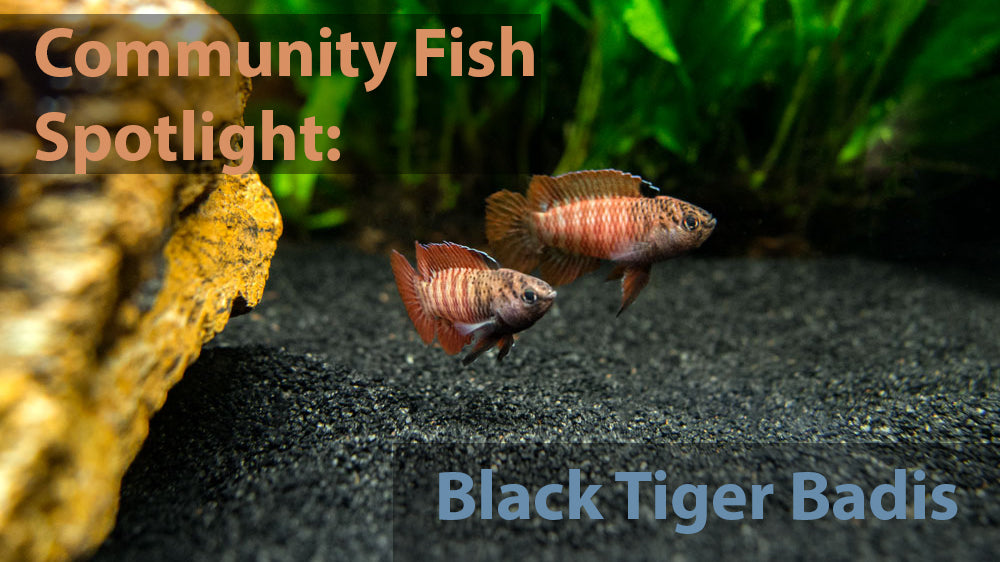Community Fish Spotlight: Black Tiger Badis (Dario sp. 'Myanmar')

Unlocking Aquatic Splendor: Delving into the World of Black Tiger Badis
In the realm of freshwater aquariums, enthusiasts are constantly seeking out unique and captivating fish species to add vibrancy and diversity to their aquatic setups. Among the many gems of the aquarium hobby is the Black Tiger Badis (Dario sp. 'Myanmar'), a strikingly beautiful fish that captivates with its exquisite coloration and intriguing behavior. Join us as we dive into the fascinating world of the Black Tiger Badis and explore why it's a standout choice for community aquariums.
Meet the Black Tiger Badis:
Hailing from the rivers and streams of Myanmar, the Black Tiger Badis is a small yet stunning fish species that belongs to the genus Dario. Characterized by its bold black stripes, vibrant orange accents, and intricate patterning, this fish is a true eye-catcher in any aquarium setting. Despite its nano size, the Black Tiger Badis possesses a distinct charm and personality that endears it to aquarists of all experience levels.

Natural Habitat: Black Tiger Badis inhabit slow-moving streams and shallow waters with dense vegetation in their native habitat of Myanmar. They are often found in areas with sandy or gravelly substrates.
Appearance:
The Black Tiger Badis boasts a striking coloration that sets it apart from other fish species. Its body is adorned with alternating black and orange stripes, reminiscent of a tiger's patterning, earning it the moniker "Black Tiger." The fins of the male Black Tiger Badis may exhibit elongated extensions, adding to its overall elegance and visual appeal. Female Black Tiger Badis typically display more subdued colors but still retain an understated beauty that complements the males' vibrant hues.
Behavior and Temperament:
The behavior and temperament of the Black Tiger Badis are as intriguing as its striking appearance. While generally peaceful, these fish can display territorial behavior, particularly during breeding periods or when establishing a hierarchy within a group. However, their territorial displays are typically more about establishing boundaries and courtship rituals than aggressive confrontations.
Despite their occasional territorial tendencies, Black Tiger Badis are compatible with a variety of peaceful tankmates, including small schooling fish, shrimp, and peaceful bottom-dwellers. Their interactions with tankmates are often curious and non-aggressive, adding to the dynamic of the aquarium community.
During feeding times, Black Tiger Badis can become quite animated, eagerly exploring their surroundings and darting around the tank in search of food. Their inquisitive nature makes them enjoyable to observe and adds a lively energy to the aquarium environment.

Shrimp Compatibility:
Black Tiger Badis are generally compatible with small freshwater shrimp species, such as Cherry Shrimp (Neocaridina davidi) or Crystal Red Shrimp (Caridina cf. cantonensis). However, caution should be exercised when keeping them together, especially with smaller or more delicate shrimp species. While Black Tiger Badis are not typically aggressive towards shrimp, they may view them as potential prey, especially if the shrimp are small or slow-moving. Providing ample hiding spots and dense vegetation can help mitigate potential conflicts and provide the shrimp with refuge from the fish. Additionally, closely monitoring their interactions and removing any aggressive individuals can help ensure the well-being of both the fish and the shrimp in the aquarium.
Tank Requirements:
Creating an ideal habitat for Black Tiger Badis involves providing them with the necessary space, hiding spots, and environmental conditions to thrive. A tank size of at least 10 gallons is suitable for a small group of these fish, with larger tanks offering more space for natural behaviors and social interactions.
Maintaining stable water parameters is essential for the health and well-being of Black Tiger Badis. They prefer slightly acidic to neutral water conditions, with temperatures ranging from 72°F to 78°F (22°C to 26°C). Regular water changes and monitoring of water parameters help ensure a healthy and stable aquatic environment for these fish.
Aquascaping:
Aquascaping is an integral aspect of creating an aesthetically pleasing and functional habitat for Black Tiger Badis. Incorporating live plants, driftwood, rocks, and other natural decor elements not only enhances the visual appeal of the aquarium but also provides essential hiding spots and refuge for the fish.
When aquascaping for Black Tiger Badis, consider incorporating a variety of plant species to create a lush and dynamic underwater landscape. Plants such as Java ferns, Cryptocoryne, and Vallisneria offer hiding spots, oxygenate the water, and help maintain water quality.
Driftwood and rocks can be strategically arranged to create caves, crevices, and overhangs, providing additional hiding spots and territorial boundaries for the fish. Natural decor elements such as botanicals, leaf litter, and dried seed pods add to the authenticity of the aquascape while releasing beneficial tannins into the water.
By carefully designing an aquascape that meets the needs of Black Tiger Badis, aquarists can create a visually stunning and functional habitat that enhances the well-being and natural behaviors of these captivating fish.
Diet and Feeding:
Black Tiger Badis are carnivorous by nature, and their diet should consist primarily of protein-rich foods. Offer them a varied diet that includes high-quality flake or pellet food supplemented with live or frozen foods such as bloodworms, brine shrimp, and small insects. Feeding them small, frequent meals throughout the day mimics their natural feeding behavior and helps ensure they receive adequate nutrition.
It's essential to monitor their feeding habits and adjust their diet accordingly to prevent overfeeding and maintain optimal health. Providing a balanced diet rich in protein and essential nutrients promotes vibrant coloration, robust growth, and overall well-being in Black Tiger Badis.

Breeding:
Breeding Black Tiger Badis in captivity is achievable with proper care and patience. Providing them with suitable spawning conditions, such as densely planted areas and soft, acidic water, encourages breeding behavior. Once a pair forms a bond, the female will lay adhesive eggs on plant leaves or other surfaces, which the male will then fertilize and guard until hatching. Raising the fry requires meticulous attention to water quality and feeding, but the reward of witnessing the entire breeding process is truly gratifying for aquarists.

In conclusion, the Black Tiger Badis (Dario sp. 'Myanmar') is a captivating and charismatic fish species that adds an undeniable allure to any freshwater aquarium. With its striking coloration, engaging behavior, and relatively straightforward care requirements, this species is a standout choice for aquarists seeking a unique and visually stunning addition to their aquatic community. Whether you're a seasoned hobbyist or a newcomer to the aquarium hobby, consider welcoming the Black Tiger Badis into your aquatic world and experience the joy of keeping these captivating fish.
Q&A Section
Q: What size group for Black Tiger Badis?
Black Tiger Badis are social fish that thrive in the company of their own kind. Keeping them in groups of at least three to five individuals is recommended to promote natural behaviors and social interactions. Larger groups provide a more dynamic and visually appealing display in the aquarium.
Q: Are Black Tiger Badis aggressive?
While Black Tiger Badis can exhibit territorial behavior, especially during breeding periods or when establishing hierarchies within a group, they are generally not considered aggressive. Their interactions with tankmates are more likely to involve displays of dominance rather than physical aggression. However, individual personalities may vary, and some fish may display more assertive behavior than others.
Q: Can you keep different dwarf Badis together?
It is generally not advisable to keep different species of dwarf Badis together in the same aquarium. While some species may appear similar in size and behavior, they may still exhibit territorial behavior and potentially aggressive interactions towards one another. Mixing different species of dwarf Badis can lead to stress, competition for resources, and even aggression, resulting in injury or death.
Q: What are common diseases in Black Tiger Badis?
Like any aquarium fish, Black Tiger Badis are susceptible to various diseases, with some common ailments including bacterial infections, fungal infections, and parasitic infestations. Poor water quality, inadequate diet, and stressors in the environment can weaken the fish's immune system and make them more susceptible to disease. Regular water changes, maintaining stable water parameters, and providing a balanced diet can help prevent common diseases in Black Tiger Badis.
Q: Who should not consider keeping Black Tiger Badis?
Individuals who are unable to provide the specific care requirements of Black Tiger Badis should reconsider keeping them. These fish thrive in well-maintained aquariums with ample hiding spots, subdued lighting, and compatible tankmates. Additionally, aquarists who are unwilling or unable to dedicate time to observe and understand the social dynamics of these fish may struggle to provide a suitable environment for them. It's essential to research and understand the needs of Black Tiger Badis before introducing them to your aquarium.
Q: What are the best tankmates for Black Tiger Badis?
A: The best tankmates for Black Tiger Badis are peaceful fish species that share similar water parameters and temperament. Ideal tankmates include small to medium-sized community fish such as peaceful tetras (e.g., Neon Tetras, Ember Tetras), Rasboras (e.g., Harlequin Rasboras, Chili Rasboras), peaceful dwarf cichlids (e.g., Apistogramma species), peaceful gouramis (e.g., Honey Gouramis, Sparkling Gouramis), small peaceful catfish (e.g., Corydoras species, Otocinclus), and peaceful shrimp species like Neocaridina Shrimp (Neocaridina davidi) or Amano Shrimp (Caridina multidentata).
Avoid keeping Black Tiger Badis with larger or more aggressive species that may intimidate or outcompete them for resources. Additionally, ensure that tankmates are not fin-nippers, as Black Tiger Badis have delicate fins that may be targeted by aggressive or fin-nipping fish. With careful selection, Black Tiger Badis can coexist harmoniously with a variety of compatible tankmates, enhancing the overall diversity and beauty of the aquarium.
For those eager to delve deeper into the world of Black Tiger Badis and uncover more about their care, behavior, and compatibility with other aquatic species, we invite you to explore the comprehensive product listing available on the Aquatic Arts website. Additionally, as a token of appreciation for our valued customers, we're delighted to offer an exclusive discount code: TAKE15, which grants a generous 15% off your order. Simply enter the code at checkout to enjoy this special offer. Please note that this discount code cannot be combined with other offer codes. Don't miss out on this opportunity to enhance your aquarium with the captivating presence of Black Tiger Badis while enjoying savings on your purchase. Visit the Aquatic Arts website today to embark on your aquatic journey with confidence and excitement.




